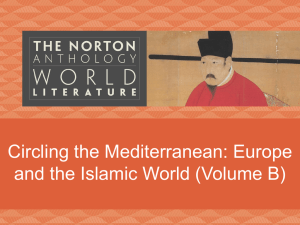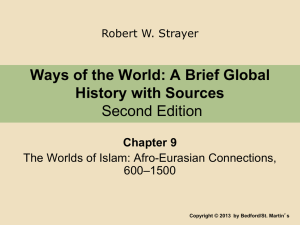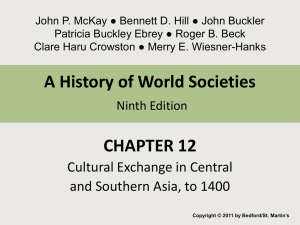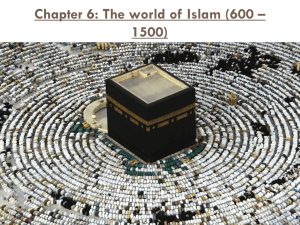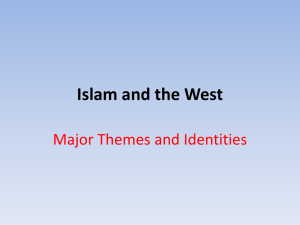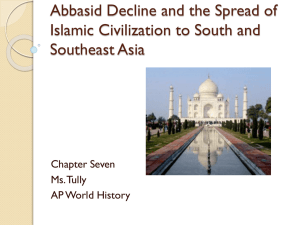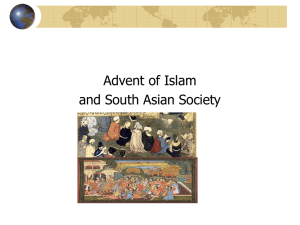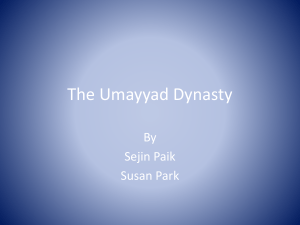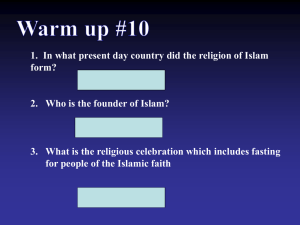Islamic Diffusion - Mounds View School Websites
advertisement
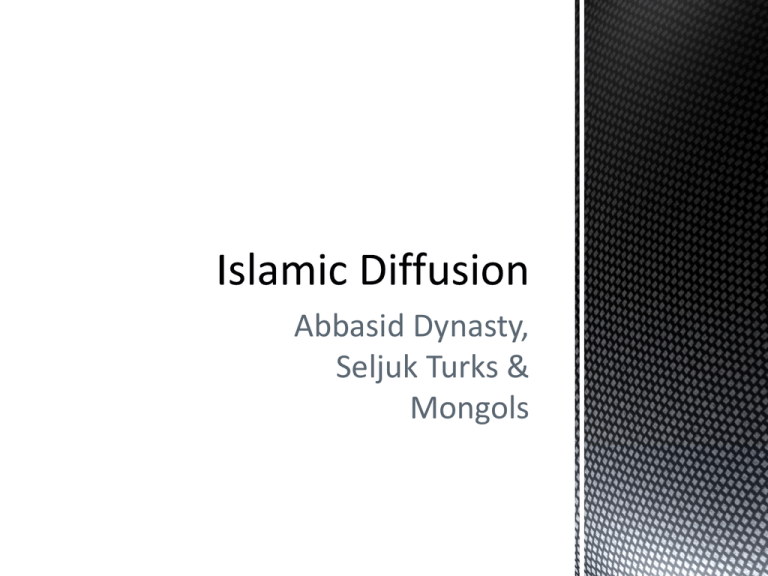
Abbasid Dynasty, Seljuk Turks & Mongols How & when was Islam introduced into the Empire? Locate and mark the empire (& major cities) on the map provided. What type of diffusion brought Islam into the empire: Relocation or Expansion? If it was expansion, then was it contagious or hierarchical? What people or conditions helped the spread or acceptance of Islam in the empire? What people or conditions hindered the spread or acceptance of Islam in the empire? Recognize Elements of Diffusion in: Abbasid Dynasty. Seljuk Turk Empire & Mongol Empire What impact did Islam have on the: Culture History Literature Architecture Politics (Be sure that you discuss the impact of Islam on each of these specifically.) Analyze Impact of Islam on the Abbasid Dynasty, Seljuk Turk Empire & Mongol Empire HAVE YOU COMPLETED THESE QUESTIONS FOR ALL THREE “EMPIRES”? IF SO, THEN PROCEED TO CHECK YOUR ANSWERS. Contagious Diffusion: born out of the Umayyad Dynasty Carriers: Soldiers/Conquest, original descendants of Muhammad’s followers Barriers: non-Arab Muslims Culture/History: Shift in importance from warriors to judges, merchants & gov’t officials; Arab & non-Arab Muslims granted equity (based on Islam ideal of equality) Literature/Architecture: Golden Age of caliphate under Harun al-Rashid - $ & support given to artists and writers Politics: bureaucracy becomes more complex & introduction of vizier gives caliph a bigger sense of spirituality Relocation Diffusion: hired as soldiers in the Fatamid Dynasty (an Islamic Empire in Egypt) & the Abbasid caliphate Carriers: rulers/government Barriers: nomadic traditions Culture/History/Politics: created an even more complex bureaucracy – Turkish sultan held political and military power while the Abbasid caliph was still the religious authority Literature/Architecture: Expanded Islamic influence into the Byzantine Empire, which meant the introduction of Islamic style architecture Contagious Diffusion Carriers: neighbors Barriers: Mongol traditions; prejudice Culture/History/Politics: Because of the destruction of Baghdad, the center of Islamic culture shifted to Cairo, Egypt Literature/Architecture: Eventually had to rebuild the cities that were destroyed by the Mongol invaders SPREAD OF ISLAM: Among the reasons for the rapid and peaceful spread of Islam was the simplicity of its doctrine. Islam calls for faith in only one God worthy of worship. The Gunpowder Empires - Muslim empires of the time; the empires success is largely based on the mastery of the technology of firearms. Contagious Diffusion: descendants of the Turks Part of Hierarchical Diffusion of Islam into new areas – as the rulers they imparted their faith & Relocation Diffusion as they expanded into new territories Carriers: Soldiers (janissaries) Wall around the city of Constantinople; Hungarians Impact of Islam: Culture Sunni Muslims. Sultans had claimed the title of caliph since the 16th century. They were responsible for guiding the flock and keeping Islamic law. Gave their religious duties to the “ulema”- a group of religious advisors Shari’ah Law – more tolerant of women Schools for educating all Muslims The Ottoman were tolerant of nonMuslims. Non-Muslims paid a tax, but they were allowed to practice their religion or to convert to Islam. Impact of Islam: History In the 14th century, the Ottomans moved into the Balkans by taking control of the Bosporus and the Dardanelles. April 6, 1453, the Ottoman Turks laid siege to the city of Constantinople. May 29, 1453, Constantinople fell to the Ottoman Turks led by Mehmet II. The Turks spent 3 days sacking the city. Many people lost their lives inside the city. The city was later renamed Istanbul. Selim I Roxelana Suleyman I Impact of Islam: Politics Sultans were the head of the empire – hereditary rule. The chief advisor to the sultan was the “grand vizier.” The empire was divided into districts and ruled by officials who were helped by bureaucrats trained at palace schools. Pashas, appointed local government officials, collected taxes and maintained law and order reported to the sultan in Constantinople Impact of Islam: Art Textiles & Rugs Jewelry Pottery Impact of Islam: Architecture Mosques Sinan the Architect Domes & Minerats Changed the architectural landscape of Eastern Europe and Northern Africa
